





It's mid-June and they ARE coming! Japanese Beetles will begin to emerge during the last week of June and continue through July. Being prepared can save you the disappointment of destroyed shrubs and ornamentals.
(Editor's Note: This article was published on June 24, 2008. Your comments are welcome, but please be aware that authors of previously published articles may not be able to respond to your questions.)
If you live east of the Mississippi, you can expect to battle Popillia japonica, a voracious feeder. Lawns, ornamental shrubs, and trees are fair game to this imported beetle that costs the turf and ornamental industry approximately $450 million each year in management and control.1 First discovered in the eastern U.S. in 1916, the consensus of opinion is that the insect arrived in a shipment of bulbs.
The adult beetle is quite distinctive: brilliant metallic green with copper-brown wing covers. The insect is oval, measuring 3/8 inch (10 mm) long and 1/4 inch (7 mm) wide.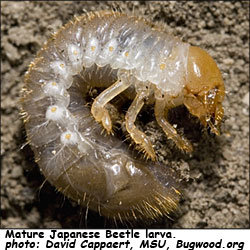 You will probably never see the eggs, but you will quickly recognize the grub (larva) stage: first instar (immature) larvae measure about 1/16 inch (1.5 mm) long, and third (mature) instars measure about 1-1/4 inch (32 mm) long. Following these stages, the pupae are recognizable by coloration: first cream, then light reddish-brown, and measuring about 1/2 inch (14 mm) long and 1/4 inch (7 mm) wide.
You will probably never see the eggs, but you will quickly recognize the grub (larva) stage: first instar (immature) larvae measure about 1/16 inch (1.5 mm) long, and third (mature) instars measure about 1-1/4 inch (32 mm) long. Following these stages, the pupae are recognizable by coloration: first cream, then light reddish-brown, and measuring about 1/2 inch (14 mm) long and 1/4 inch (7 mm) wide.
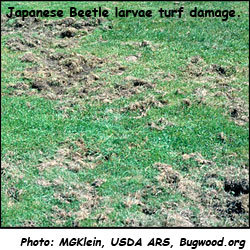
Take a look at your turfgrass; if it resembles the photo here, beetle grubs are at work beneath the surface. The turf starts out looking as though it's been under-watered, and it feels spongy underfoot. Additionally, if you find large areas where your grass has been scraped away, it means that raccoons, skunks, and opossums are foraging for the plump grubs beneath the turf.
Lacy leaves! Adult beetles eat the leaf tissue between the veins, producing a skeleton of the leaf. The leaf soon withers and dies. Once a swarm of beetles settles onto a tree or shrub, they can destroy the plant overnight. The stress of this type of damage weakens the plant's resistance, and it will often die 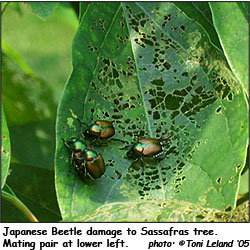 over the winter. Adult beetles will also attack flower buds and fruit, especially roses, strawberries, and tomatoes. A list of favored host plants follows this article.
over the winter. Adult beetles will also attack flower buds and fruit, especially roses, strawberries, and tomatoes. A list of favored host plants follows this article.
The first beetles out of the ground begin to feed immediately; at the same time, they release an odor that attracts later-emerging adults and, suddenly, hundreds of beetles congregate on a single plant. Within hours, the new females also release a sex pheromone which, in turn, attracts even more beetles. After a couple of days, the females burrow into the ground and lay eggs, then return to their feeding and mating site. The cycle continues until 40 to 60 eggs have been laid, generally by mid-August.
The scary point here is that the females lay their eggs within the first 7 to 10 days of their existence! Most products for eliminating Japanese Beetle larvae are applied in May or June; for small properties, these products are quite feasible, but for large areas, the cost can be prohibitive.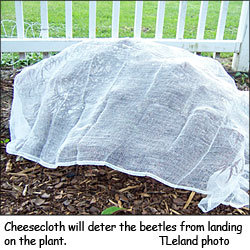
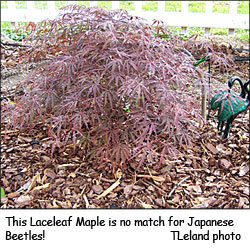 However--taking measures before this year's herd emerges can save you some grief. If you have small ornamentals, shrubs, plants, or trees that are close to the ground and easily accessible, try wrapping them with cheesecloth or similar small-mesh material to keep the beetles from settling there. Do this as soon as you see even ONE adult beetle anywhere in your vicinity. The first beetles to emerge crawl up on the nearest host and begin sending welcome signals to all those who will emerge over the next few days. The unfortunate plant hasn't a chance!
However--taking measures before this year's herd emerges can save you some grief. If you have small ornamentals, shrubs, plants, or trees that are close to the ground and easily accessible, try wrapping them with cheesecloth or similar small-mesh material to keep the beetles from settling there. Do this as soon as you see even ONE adult beetle anywhere in your vicinity. The first beetles to emerge crawl up on the nearest host and begin sending welcome signals to all those who will emerge over the next few days. The unfortunate plant hasn't a chance!
Larger trees present more of a problem and, unfortunately, cannot be protected once infested. One can only hope they are healthy enough to survive the stress and come back the following year.
Control methods outlined by Ohio State University Extension2 include
With the exception of trapping, all of the above methods deal with the larval stages.
Habitat modification:
Arborvitae
Ash
Boxwood
Cedar
Euonymus
Flowering dogwood
Forsythia
Holly
Hydrangea
Juniper
Lilac
Magnolia
Privet
Red maple
Red mulberry
Red oak
Silver maple
Spruce
Tulip tree
Yew
This will probably generate dozens of forum comments, but use of Japanese Beetle traps has pros and cons. Many articles state that the traps only attract more beetles than you might already have. I have personally found this to be untrue for my own rural area. I live on an acre and a half, with no close neighbors, but lots of forest and swamp lands in the immediate area.
In 2005, Japanese Beetles almost destroyed a young Sassafras tree I'd been nurturing. I toured the property, looking for other hosts that had beetles, but found only a Firethorn bush with small numbers of the critters hanging out. Interestingly, no leaf damage. I hosed the beetles off the Sassafras with a strong stream of water, then sprayed the fallen insects with insecticidal soap. (see recipe in "How to Kill Weeds and Insects...") The poor tree lost all its leaves and I was sure it was a goner.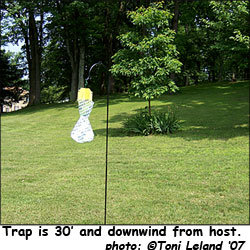 The following spring, Ms. Sassafras came out in full leaf and I determined the beetles wouldn't have their way with her again. I purchased a beetle trap and set it up about 30 feet away. When the hoards arrived, they filled four bags on the trap, and only slightly chewed some lower leaves on the tree.
The following spring, Ms. Sassafras came out in full leaf and I determined the beetles wouldn't have their way with her again. I purchased a beetle trap and set it up about 30 feet away. When the hoards arrived, they filled four bags on the trap, and only slightly chewed some lower leaves on the tree.
You'll need to make your own determination as to whether you want to try trapping. In tight neighborhoods, you could conceivably attract beetles from other houses, but my thinking is, if they go to the traps and not the plants, what difference does it make? (Bracing myself for the e-mails!)
The traps contain a combination scent of sex pheromone and floral (food) lure which is irresistible to the beetles. Adult beetles are most active (flying) on sunny, warm (70F - 90F) days between 10 a.m. and 3 p.m. The beetle flies toward the scent, bumps into the baffle, and falls into the bag, never to climb out again. Most brands of trap last the full season, providing at least two bags.
Whatever method you choose to combat the Japanese Beetle, do it now. They are COMING.
- Apple
- Asparagus
- Aster
- Basil
- Basswood
- Bayberry
- Birch
- Blackberries
- Blueberry
- Buckeye/Horse Chestnut
- Buddleia
- Caladium
- Canna
- Carrots
- Chrysanthemum
- Coral Bells
- Corn
- Cosmos
- Cranberry
- Crape Myrtle
- Dahlia
- Daylily
- Digitalis
- Echinacea
- Eggplant
- Elder
- Elm
- Flowering Quince
- Grapes
- Heather
- Hibiscus
- Holly
- Hollyhock/Rose of Sharon
- Hydrangea
- Iris
- Knotweed
- Liatris
- Lime
- Linden
- Mallow
- Maple
- Ninebark
- Oak
- Peaches
- Pears
- Peas
- Peppers
- Phlox
- Pistachio
- Plums
- Poison Ivy
- Primrose
- Privet
- Prune
- Raspberries
- Rhododendron
- Rhubarb
- Rose
- Roses
- Sassafras
- Scarlet Runner Bean
- Strawberries
- Sycamore
- Thistle
- Tomatoes
- Viburnum
- Virginia Creeper
- Weigelia
- Willow
- Wisteria
- Zinnia
1. Laumer, John. "Japanese Beetles: Climate Invaders on the March," Philadelphia, 8/6/06.
2. Shetlar, David J. "Japanese Beetle," Ohio State University Extension Fact Sheet # HYG-2504-91, viewed 5/14/08
3. http://en.wikipedia.org/wiki/Japanese_Beetle
Copyright © www.100flowers.win Botanic Garden All Rights Reserved